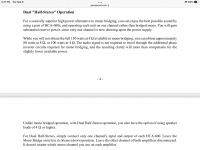I‘ve never heard of this ‘half stereo’ designation before (see pic) also including link to the whole manual.
https://www.parasound.com/pdfs/vintage/hca600om.pdf
https://www.parasound.com/pdfs/vintage/hca600om.pdf
Attachments
Not apply to dual mono amplifier, or some multi channel amplifier which has completely independent power supplies for each channel.Is this across the board with all amps or just model specific?
Last edited:
That makes sense, it just caught my attention while reading the manual…….theres two on usam for $95 each.
a good recap candidate? All reviews (even recent) state decent sound and bulletproof.
a good recap candidate? All reviews (even recent) state decent sound and bulletproof.
A cheap tirck for beefing up an amplifiers power supply.
I essentially did just that with a pair of QUAD 303.
https://www.t-linespeakers.org/FALL/Q303.html
dave
I essentially did just that with a pair of QUAD 303.
https://www.t-linespeakers.org/FALL/Q303.html
dave
I don't see how you can possibly get more power out of a 303 without increasing the rail voltage.
It does not increase the power, it just increases PS stiffness. And the 303 sorely needs it.
As mentioned by Chris that the channels need to share a PS.
dave
As mentioned by Chris that the channels need to share a PS.
dave
Slight. Not worth talking about. It does maintain the same power when as a stereo amp the supply would sag and the amp puts out less power.
dave
dave
Black Cerafines in a Quad?! Goodness!
Those amps were stopped up by a local eleclonics guy for the Navy. He worked them over a way more. I am told they were very good.
dave
dave
Note that their claim of clarity improvement is not just due to the power supply effects, but also whatever it is they use to invert the signal to the "2nd" amp to make the bridge.
Some designs I've seen use the whole 1st amplifier for such, as it happens to be inverting already and makes for a cheap solution to provide the bridging feature.
So they're advocating less signal path for the audio signal to travel through, as well as less tax on the PS - in exchange for less - perhaps - driver-frying capability. A good compromise intelligently suggested.
Some designs I've seen use the whole 1st amplifier for such, as it happens to be inverting already and makes for a cheap solution to provide the bridging feature.
So they're advocating less signal path for the audio signal to travel through, as well as less tax on the PS - in exchange for less - perhaps - driver-frying capability. A good compromise intelligently suggested.
"...In the bridge mode each channel of the amplifier functions for only the + or - half of the musical waveform. Thus, each channel “sees” only half of the speaker's impedance..."
What?!
What?!
- Home
- Amplifiers
- Solid State
- Is this across the board with all amps or just model specific?
